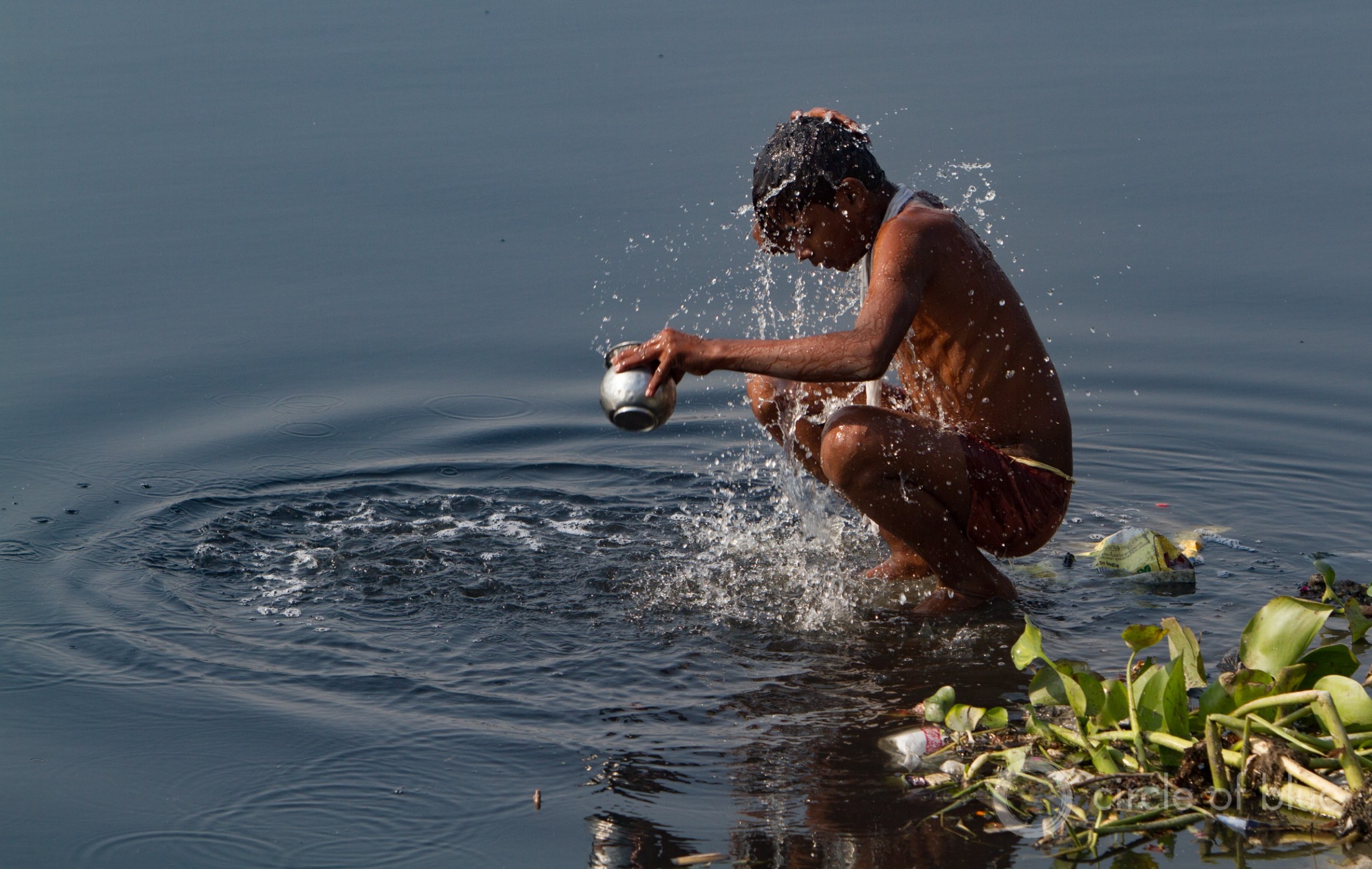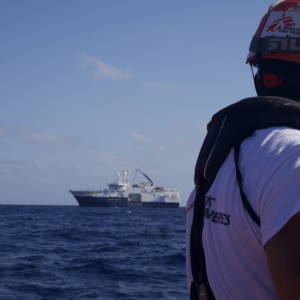The Three Ages of Water looks back at history to write a prescription for tomorrow.

A boy in Delhi, India’s capital, cools himself in a river. Photo © J. Carl Ganter/Circle of Blue
By Brett Walton, Circle of Blue – August 21, 2023
The targets, in hindsight, were obvious choices.
Amid a brutal campaign a decade ago to claim a caliphate across the lands of Mesopotamia, the insurgent group the Islamic State sought to control the region’s choke points. In the desert, that means water. In northern Syria, its fighters seized Tabqa Dam. Proceeding eastward they commanded the decrepit Mosul Dam on the Tigris River in northern Iraq. A third target, Fallujah Dam, was just as strategic.
The structure west of Baghdad diverts water from the Euphrates River for irrigation. Together, the Tigris and Euphrates are the famed waterways of Mesopotamia, cradles of civilizations and present-day lifelines for farmers and cities in Syria, Iraq, and Turkey.
Upon taking control of Fallujah Dam, Islamic state insurgents promptly shut the gates. Downstream, the water supply for the holy cities of Karbala and Najaf was cut off. Upstream, crops were destroyed and livestock killed as the impounded waters flooded hundreds of square kilometers of land.
The events of 2014 echoed the region’s history. Nearly three thousand years earlier, the Assyrian king Sargon II destroyed an irrigation system in southern Mesopotamia during a military campaign against the Chaldeans. It was one of many acts of violence, in the Fertile Crescent and elsewhere, in which water systems were the target.
These conflicts are among the stories recounted in The Three Ages of Water, a new book by scientist Peter Gleick that traces the arc of society through its relationship with the most elemental of human needs.
“Water is us,” Gleick writes. And, he argues, we’re committing a series of self-inflicted wounds.
Studded with big themes and historical sweep, the book is a history and a blueprint. There’s conflict and violence over water. But also groundwater depletion, scientific advances, agricultural revolutions, life-giving improvements in public health, legal codes to manage scarce supplies, and the misery of those left behind.
Not to be overshadowed by trends and ideas, fascinating characters populate the pages. Famous and obscure, these are the people who moved history. John Snow, the disease detective who proved that a cholera outbreak in Victorian London was spread not by foul air but by tainted water. John Leal, the physician who first chlorinated a major city’s drinking water supply in order to kill off harmful bacteria. And Mesalim, the king of the Sumerian city-state of Kish who, 4,500 years ago, brokered a legal treaty to intervene in the first documented water conflict, which was also in the lands of Mesopotamia.
Gleick, co-founder and senior fellow at the Pacific Institute and a Circle of Blue board member, depicts the history of water in three acts, or ages.
The first age was defined by survival. Early humans hunted, gathered, and then mostly settled, founding civilizations in prominent river valleys. The first works of water engineering — dams, aqueducts, and irrigation systems — were developed. The human relationship to water, at this point, “was both central and unplanned — but always intimate.”
The second age was marked by acceleration and control. Knowledge of biology, chemistry, and physics expanded rapidly with the scientific revolutions of the 17th and 18th centuries, advances that later underpinned public health victories.
At the same time, new learnings opened the door to dominion at unprecedented scale. Nature was corralled, leashed, harnessed, colonized, exploited, and extracted. Polluted rivers caught fire. Dams blocked rivers for hydropower. Canals punctured hundreds of kilometers into the drylands, bringing irrigation water and land cultivation. Wetlands were diked and drained.
All of this development blunted the sharp edge of nature’s uncertainties. Large-scale engineering provided for an astronomical increase in material wealth, and longer lives. Deaths from waterborne diseases in the United States essentially vanished after Leal’s chlorination experiment caught on. But many people are not so fortunate. Diarrhea remains one of the leading causes of death globally for children under age 5. Roughly 2 billion people do not have safe drinking water.
Gleick argues that we are now at the cusp of a third age of water — “a fork in the road of our own survival” — when society must reckon with the crises brought on by the excesses of the second. Just as the energy sector must transition away from fossil fuels, society needs to revamp its relationship with water.
If society does not, there is dystopia. But Gleick does not countenance it. Instead he offers a blueprint for a sustainable transition. The blueprint is informed by his decades of research into something called the “soft path.” This means prizing water-sipping appliances and technology that cleans and reuses water. It means restoring ecosystems and re-valuing rivers. It means shifts in policy and law. In this vision, all people have sufficient clean water and sanitation. It means rapidly cutting planet-warming greenhouse gas emissions, for climate change is a water disruptor.
How to achieve this? All policy is implementation, as political scientists like to say. But that is beyond the scope of the book. Gleick does frequently remind readers that walking this soft path does not require an inconceivable detour. The tools and waypoints already exist. The key challenges, he says, are neither membranes nor money.
“There are no insurmountable technological or economic roadblocks to a positive Third Age of Water,” Gleick writes. “But whether we can overcome the political, social, and cultural obstacles that remain depends on the choices we make and how quickly we act.”
Those obstacles — political, social, cultural — are the true tests. Is unanimity possible as the world cracks under unbearable heat? What are we willing to sacrifice today for a calmer tomorrow? Can the momentous stakes overcome the viciousness of near-sighted politics and the echoes of history? Will we act quickly?
These are the unknowns in this uncertain third age.
Brett writes about agriculture, energy, infrastructure, and the politics and economics of water in the United States. He also writes the Federal Water Tap, Circle of Blue’s weekly digest of U.S. government water news. He is the winner of two Society of Environmental Journalists reporting awards, one of the top honors in American environmental journalism: first place for explanatory reporting for a series on septic system pollution in the United States(2016) and third place for beat reporting in a small market (2014). He received the Sierra Club’s Distinguished Service Award in 2018. Brett lives in Seattle, where he hikes the mountains and bakes pies. Contact Brett Walton




